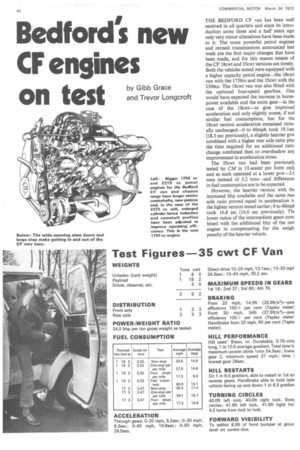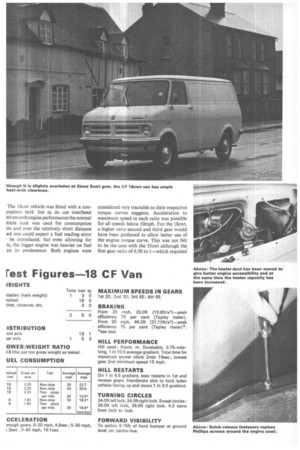Bedford's new CF engines on test
Page 42

Page 43

Page 44

If you've noticed an error in this article please click here to report it so we can fix it.
by Gibb Grace and Trevor Longcroft
THE BEDFORD CF van has been well received in all quarters and since its introduction some three and a half years ago only very minor alterations have been made to it. The more powerful petrol engines and revised transmissions announced last week are the first major changes that have been made, and for this reason retests of the CF 18cwt and 35cwt versions are timely. Both the vehicles tested were equipped with a higher capacity petrol engine-the 18cw1 van with the 1759cc and the 35cwt with the 2300cc. The 18cwt van was also fitted with the optional four-speed gearbox. One would have expected the increase in horsepower available and the extra gear-in the case of the 18cwt-to give improved acceleration and only slightly worse, if noi similar fuel consumption, but for the 18cwt version acceleration remained virtu. ally unchanged-0 to 40mph took 19.1sec (18.3 sec previously), a slightly heavier gvIn combined with a higher rear axle ratio pith the time required for an additional ratic change combined then to overshadow an improvement in acceleration times.
The 35cwt van had been previous13 tested by CM in 12-seater psv form on13 and as such operated at a lower gvw-2A tons instead of 3.2 tons-and difference: in fuel consumption are to be expected.
However, the heavier version with du increased bhp available and the same ma] axle ratio proved equal in acceleration tc the lighter version tested earlier; 0 to 40mpl took 16.8 sec (16.6 sec previously). Thi lower ratios of the intermediate gears corn bined with the additional bhp of the nev engine in compensating for the weigh penalty of the heavier vehicle.
The 18cwt vehicle was fitted with a conimption tank but as its use interfered ith smooth engine performance the normal thicle tank was used for consumption sts and over the relatively short distance ted one could expect a fuel reading error be introduced, but even allowing for is, the bigger engine was heavier on fuel an its predecessor. Both engines were considered very tractable as their respective torque curves suggests. Acceleration to maximum speed in each ratio was possible for all speeds below 10mph. For the 18cwt, a higher ratio second and third gear would have been preferred to allow better use of the engine torque curve. This was not felt to be the case with the 35cwt although the first gear ratio of 6.50 to 1—which required a quick change to second when pulling away—could perhaps be reduced.
For the 18cwt the gearbox proved to be light and quick to use, but the 35cwt proved otherwise. There was no synchromesh on first gear and changes between gears required some effort, the gear change mechanism being stiff.
Good brakes
Both vehicles returned good braking figures, notably the 35cwt which returned stopping distances of 14.9ft at 20mph and 34ft from 30mph. Peak deceleration exceeded one "g" for both these distances. The vehicle did tend to pull toward the nearside for these maximum pressure stops and this was attributed to the camber of the road. However, later driving of the vehicle showed a slight pull to the nearside for a light brake application caused possibly by a slight out-of-balance adjustment of the front brakes.
Ride and handling
The 35cwt van gave good ride quality on most road surfaces, although on certain stretches of uneven road a high frequency low amplitude bounce was experienced for a short time at the front of the vehicle. The 18cwt van, with its long rear springs gave a similar quality ride, but the same springs gave rise to an unsafe oversteer feeling on bends. A turn on the wheel to negotiate a bend was exaggerated by body sway so that in the worst instances some steer angle had to be taken off. On a straight road a similar effect could be invoked by a quick snatch at the wheel, the vehicle swerved as a result of the snatch but, instead of quickly straightening out as might be expected, the swerve tended to be over-corrected and the result was that the vehicle weaved from side to side for a considerable distance. At normal speeds on normal roads this characteristic was only mildly felt, and not in any way frightening or dangerous, but at 60mph on motorways it was more pronounced. The handling was sufficiently worrying so as to limit the high speed run to a brief spell at 65mph---although, from the sound of the engine, the attainable top speed was certainly higher.
The 18cwt test vehicle had optional heavy-duty springs fitted which had a considerably higher rate than standard, and uprated dampers fitted, Test weights were stowed at floor level and so presumably a vehicle fitted with standard springs and a high centre of gravity load would exhibit this characteristic even more markedly.
As tested the CF was about one hundredweight over its permissible gvw but neither axle was over-loaded and the proportion of load front to rear was correct.
Driver comfort
The driver's seat was comfortable but only adjustable fore and aft, and was set a little too low for a six-footer. The steering wheel lined up with the centre of the seat but the steering column was angled so that its bottom end was closer to the middle of the vehicle and one tester found this fouled his clutch foot. The brake pedal was conveniently placed but the accelerator is positioned close to the wheel arch and consequently the right foot had to be held at an awkward angle to operate it. All instruments are housed in a large binnacle mounted ahead of the steering wheel and were very easy to read. The only criticism one could make here was that the wiper and washer buttons, which are to the top and bottom of the binnacle respectively, could not be operated from the same direction, ie the wiper is operated most easily through the wheel while the washei is operated most easily from around the wheel.
To sum up, the CF is undoubtedly a well conceived and well built van. We appreci ated the good forward visibility, the accurate steering, the good brakes, the improved heating, the low interior noise leve and the complete -absence of' squeaks an rattles. The larger engines gave both vam improved tractability but in the case of the 18cwt van only at the expense of poorei fuel consumption. However, as the nev, engines only require cheap low octane fuel running costs should be similar.
Bedford check
A check of the 18cwt van by Bedforc Engineers revealed that the rear tyre pressures were 5 psi under-inflated and the engine timing was incorrect. With these twc faults rectified CM briefly retested the vat this week and found it now returned, full] laden, a fuel consumption of 24.4 mpg at at average speed of 27 mph on normal roads and 19.2 mpg at 61 mph on motorways.
The increase in rear tyre pressures, . found, improved the handling considerably A Bedford engineer pointed out that th( heavy-duty option (stiffer spring rates suspension is advisable wherever a coach built body is to be fitted. The heavie suspension will help to minimize roil an( thus improve vehicle handling and stability an important consideration when a loft( has a high centre of gravity.




















































































































































